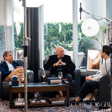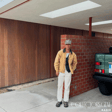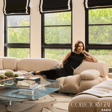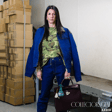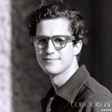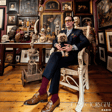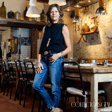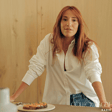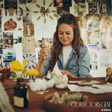Resurrection: From Funeral Parlor to Fashion
00:00:00
Speaker
We rented a space that was a funeral parlor, had never been anything but a funeral parlor. It's a small space with ah ah a rectangle in the floor that dropped down to the basement that lifted the coffins up into the funeral parlor and converted it into a retail store. And and that's the origin of the name resurrection, was that it was a funeral parlor and sort of a play on bringing all these great clothes back.
The Collector's Gene: Myth or Reality?
00:00:28
Speaker
What's going on everybody and welcome to collector's gene radio. This is all about diving into the nuances of collecting and ultimately finding out whether or not our guests have what we like to call the collector's gene. If you have the time, please subscribe and leave a review. It truly helps. Thanks a bunch for listening and please enjoy today's guest on collector's gene radio.
Mark Cadawi's Collector Journey
00:00:53
Speaker
Mark Cadawi is my guest today and it's not very common you meet a collector with such refined taste in multiple categories. Everything from his cars and art to architecture and watches, it should come as no shock that the founder of Resurrection Vintage and restorer of some of the most important homes in history has his collecting down to a science. While a lot of things in life are about being in the right place at the right time, you simply couldn't achieve what Mark has achieved if you didn't have the fervor to do so. Growing up in a family of collectors, he was bound to catch the bug himself, but a Ferrari 250 short wheelbase parked outside the Lautner Harpel house still requires a pinch-me moment when he takes the car out to breakfast on the weekend. He's as curated as it gets and truly believes that incorporating his collections into his everyday life is of the utmost importance. So without further ado, this is Marc Adawi for Collector's Dream Radio. Marc Adawi, it is such an honor and a pleasure to have you on Collector's Dream Radio today.
00:01:48
Speaker
Cameron, great to be here. So there's so much to talk about because if anyone knows you, they know that you're a true collector and a connoisseur on so many different levels, but it all kind of starts with your father and your uncle, is that correct? That's right. Yeah. I mean, I really grew up exposed to ah collecting
Influence of Family and European Travels
00:02:08
Speaker
in general. And my father was a collector of, you know, art and I would say antiquities, African, pre-Columbian art, my uncle, a collector of art and and antique furniture. And you used to go to Europe in the summer with your father and back then runners would just kind of bring him things, right? Well, yeah, I went, I traveled with my father quite a bit and
00:02:32
Speaker
father was on sabbatical when I was about 12 in Cairo. And when we were there, he ah would have you know runners bringing antiquities. And you know I ended up with some small trinkets and fragments of antiquities. And I think that that may have been the very beginning of me feeling the idea of you know collecting and putting things away. Yeah. that I mean, I find the the Europe thing to be so interesting because I feel like in in the US here, and this isn't a dig at anybody, but a lot of people in the US s don't have anywhere near the same tastes that people in Europe do. And I feel like going to Europe at such a young age and being exposed to that had to have given you this sense of ah design and this sense of collectability for lack of a better term, but but value.
Philosophy of Integrating Collections
00:03:22
Speaker
Yeah, I mean, I think that I was really fortunate on the exposure front and and that is that, you know, I think that exposure is one aspect of connecting with something and and the other is just having a connection with it. You know, for instance, my siblings aren't interested. I don't want to say they're not interested in art, but they're not interested in in the way that I am. They don't collect in the way that I do and and they haven't made it a part of their their lives in the way that I have so you know it's not only exposure and they had the same exposure that I ah had so you know I think just like anything else there's just a connection and a gravitation that one either has or doesn't have towards something whether it's collecting or music or whatnot.
00:04:07
Speaker
my experience traveling with my mother to Germany almost every summer um was spending time with my uncle and I think you know for me thinking back on it and those experiences and the way that my uncle collected It wasn't only really about collecting.
The Internet's Impact on Collecting
00:04:27
Speaker
was I think the first time really resonated with me that it was ah it was it was a way of living and and not just collecting, but how these things integrate into one's lives, how one lives with things, how one creates a ah sort of ah ah broader sort of narrative or or feel within one's environment, whether it's the architecture and things that are in the architecture. and
00:04:51
Speaker
you know the car that's parked in the garage and you know all of this in such a way that it doesn't feel doesn't feel as conscious as a collection. It feels very you sort of natural in in in that it is. I think for me, I definitely am a collector. i In some strange way, I don't really think of myself as a collector because it you know just is
From Flea Markets to Pre-Columbian Artifacts
00:05:12
Speaker
so so natural. second yeah Does the whole runner thing still exist? I mean, you don't really hear about it too often, and the concept of it is so fascinating to me. Well, for me, you know i've I've lived half my collecting life you know in an analog world, and I would say half of it in a digital world. And and so much has changed in in that way, and and the internet changed so many things in terms of
00:05:39
Speaker
hunting and collecting. it And in terms of runners, there's probably more people sending pictures of things over the internet than there are actually you know showing up in your place with ah you know a box of watches or ah you know or a suitcase with you know whatever might be in it. So you know I think the world has just changed in that respect. And I think in some ways, you know certainly for the good, and I think in some ways, not so much. thinking back of my earlier days of collecting, you know what it took to figure something out you know was completely different. you might You might buy something because on some level you just know it's great and you don't know what it is yet. And then comes the research aspect of it and certainly research without the internet was ah a completely different thing.
00:06:28
Speaker
It paints a really interesting story right off the bat because you know I remember being young and collecting something wasn't really too common to see. So as a young person, you're already in this collecting
Resurrection Vintage: A New Beginning
00:06:43
Speaker
mindset. And towards the end of high school, you moved to Berkeley, which was actually pretty pivotal in your collecting because that's when you started to hit flea markets and really get your hands on fantastic modern furniture. Yeah, I mean, that was, um you know, I started you know being really interested in design. And I had grown up around, you know, it was just the furniture we lived with, Eames chairs, Bertoya chairs, and, you know, and we we lived with modern furniture. It's what my parents bought.
00:07:12
Speaker
not used, they bought it new, and that's what what I lived with. and so i you know there was That was um certainly an aesthetic I was familiar with, but um i I can't say that my early collecting days were really that remarkable from a design standpoint. I think I just started buying anything that I thought was interesting and old, you know whether it was industrial design. and or furniture, but as one does, one starts to you know sort of refine one's aesthetic and learn more and and gravitate towards different things and ah what one sees as better things. And so that was really the beginning of my collecting and I just, I really never stopped. And I think that, you know, my collecting
00:07:56
Speaker
um as most collectors do, you know was was somewhat of a business in that I would buy and sell and keep some things and sell other things and get better things. And you know and so it was a constant sort of shuffling of of um of things. But I would say in that in those days, early days, you know so mostly design, and and then i I sort of start collecting art and I started collecting and dealing in pre-Columbian art sort of in my early 20s. And was dealing and collecting art before you started Resurrection Vintage?
00:08:34
Speaker
Yeah, I started Resurrection in 1996 when I was 26 years old. So I hadn't really i mean i had i had bought i i bought old clothes and vintage clothes from flea markets for myself, but never ah really had a great understanding of clothing or knowledge of of clothing. and my girlfriend at the time when we split up, she moved to New York. And so that would have been around 1995. And she had the idea to open a vintage clothing store and called me, you know, one day and sort of said, hey, do you want to do this? And I had really i mean my my um interest was more in art and design. And I had sort of had my thoughts on opening a gallery at some point. And but I saw that as as kind of an interesting opportunity. And, you know,
00:09:28
Speaker
Shortly after that, we had we had opened Resurrection in New York, which was also a very different
Architectural Restoration in Los Angeles
00:09:34
Speaker
time. We rented a space that was on 7th between 1st and A um in the East Village, which was a ah funeral parlor. It had never been anything but a funeral parlor. It was a small space with a ah a rectangle in the floor that dropped down to the basement that lifted the coffins up into the funeral parlor and converted it into a retail store. And and and that's the origin of the name resurrection, was that it was a funeral parlor and sort of a play on bringing all these great clothes back. And you know resurrection was really, I would say, one of the first
00:10:11
Speaker
vintage clothing stores to present vintage clothing in the way that we did, which was really, you know, hyper edited and much more fashion than it was, you know, sort of the dusty vintage clothing store that people were accustomed to. Sure. You were doing like vintage designer and archival pieces and all that stuff. Yeah. And we were dealing in, you know, great Pierre Cardin and Koresh and Paco Rabanne and both Katie, my partner, and my take on it was, it was fashion, it was design, it was, um so, you know, we had we we got to sort of curate it in ah in a way that felt very in line with what our interests were. And at what point do you start to get into design and architectural restoration?
00:10:59
Speaker
I really found architecture through design, meaning that I was much deeper in in the furniture and design world and then, you know, through that and discovered architecture and um the connection between the two. And I had a, my first house at Berkeley, I bought, I was about 24 and I was just a bungalow house in the flats. Then I bought a modern house that wasn't by a noted architect in the hills. And I did a lot of work on that and sort of made it the best you know house I could make it, given the fact it wasn't a particularly dynamic piece of architecture.
00:11:41
Speaker
and then i sort of decided that I was going to move to LA. So I started to look for architecture.
Balancing Original Design with Modern Needs
00:11:50
Speaker
There's so much great residential architecture and um the idea was to find a great house. and I chased a few different houses and a few think know things didn't come through and then one day ah Peter Koenig's Case Study 21 came on the market and i ah you know it was a house I always loved and you know from images and books. and I bought it that first day it was on the market without ever coming down to see it and a month later I moved into it. so It was a quick move to LA. I landed in an incredible
00:12:24
Speaker
house, almost a fantasy in some ways, you know to think that here is this iconic house that I always you know looked at with admiration and and then I was living in it. And and that was you know sort of my first real connection to historic architecture in that way. and You know, my work in architecture really started there. I did work on that house, although that house had largely been um restored prior to my ownership with Pierre Koenig involved while he was still alive. and I then, you know, I i sort of refined various elements of it. And during that time I was there,
00:13:05
Speaker
I met someone who became a good friend of mine and who also really was interested in architecture and in creating a world of his own in LA. It was ah Mark Seliger, who's a photographer who works out of New York and um you know said to me, hey, you know if you could if you can find me a great house, ah you know shooting in LA a lot, i'd I'd love to find something. And during the time I was looking for houses in LA prior to buying the Koenighaus, there was a house that was sort of around in that it seemed like something was going to happen with it, which was ah Richard Neutra's wear-in house.
00:13:48
Speaker
It ended up not being for sale during the time I was looking. and When Mark had come to me, shortly after that, it came up for sale. and It was a probate sale and they had ah an accepted offer on it. and ah The way probate sale works is that you're able on a given date to go into court and just bid as if it's an auction. And you know I took Mark to see it and he said, well, you know this is incredible. And the house was in terrible condition, ah but an incredible house and an incredible lot. He said, if you'll restore this house, then you know I'll buy it. and
00:14:30
Speaker
it wast It's really amazing and and this this story is a story i've I've told oftentimes more recently because it's really hit me and in a way as to you know the amount of trust and confidence that Mark had in me and that he had ah his business manager give me a power of attorney. and i went to court to bid on the house with no real instruction of what my limit was to buy it. and you know I called him afterwards and I said, you know we got the house. and He said, oh great, you know how much for? and The accepted offer was $900,000 and I think we paid $1,580,000 for it, which sounds cheap by today's standards. you know today short ten million dollar house but
00:15:18
Speaker
um Anyway, it that was my you know that was my first project that I ever did for a client. and Without that, it would have probably been a different trajectory, whatever whatever that would have been. so um so i you know I always think of ah Mark in that way. um just ah you know that in In a lot of ways, he really you know gave me my um start working in this world. And you know from there, it really happened just very organically. you know One person saw what I was doing and wanted me to work with them. And it it just sort of happened. It wasn't something I really set out to to do. It wasn't as if um i I thought, oh, you know this is what I want to do. This is how I'm going to do it. And this is my plan. This is my 10-year plan. you know I just had a door open.
Living with Collections: Enjoyment and Use
00:16:10
Speaker
And um i I just continued to walk through open doors.
00:16:14
Speaker
What kind of restoration did that house need? I mean, it needed everything. It was very original, but it was just completely dilapidated. So it was a four-year project that was just a complete renovation. And Mark ended up selling that house, I think, in around 2014, fourteen something like that. And I continue to work on that house for the new owner who become a friend as well. Amazing. When a house is dilapidated like that, but it's in original condition, does it at least make the restoration portion of it a little bit easier because you have to you don't have to use as many archive photos or records to see what it should have been?
00:16:57
Speaker
Absolutely. I think with a restoration, it's always you know sort of what's there and photographs and plans. Plans are great and can be helpful depending on whether the architect followed the plans exactly. And that's not often the case theyre not always the case, I would say. But certainly if you were to like restoring anything, whether it's restoring a car or a house or anything else, I think that getting something that is intact and unaltered, even if it's in bad shape, is the ideal condition.
00:17:28
Speaker
I know everyone has their own thoughts on collecting and what it means to be a collector, but when I look at the type of homes that you've worked on, I truly believe that you have to be a collector even if you own just one because they are that special, they take that much attention, and you really have to seek them out, sometimes uproot your life right from where you're currently living just so you can reside in one of these homes. Does it ever cross your mind that people want to collect and live in these homes because you've put your name on it. I never really think about it like that I mean I think the architecture always speaks for itself and honestly I try to take myself out of it as much as possible I think that you know. You're dealing with great architecture and you're you're trying to bring something back.
00:18:15
Speaker
you know I think one can take credit for doing a good job with that, but it's really about trying to let the architect you know speak from the past. and you know there's certainly As it seems like it should be easy to restore something, there are many cases in which things aren't well done. and so We just finished a multi-year restoration of Pierre Koenig's case study 21, which i I mentioned before is the house first house I lived in in LA. So i you know I lived in that house. I sold it at auction in 2006 when I bought the Lautner Harpel house.
00:18:53
Speaker
and it had the one subsequent owner that had had purchased it at auction and then came up for sale again and a client of mine bought it. So I actually got to you know go back to that house as not as the owner and do a very compar comprehensive historical restoration of it, which is is great. And it's just now completed. And to have done that, I mean you you pretty much had to have either been ultra familiar with the property or have lived in it like you did to be able to do a comprehensive restoration, I would assume.
00:19:27
Speaker
Well, I mean, it certainly didn't didn't hurt to do that, although we weren't using all the archival photographs, the the plans, and we had a lot of structural challenges with that house. as It was slipping down the hill, so that was really the first issue to tackle. But it's been a great project. was It was an incredible client who understood what it took and wanted to see it through and and really gave us the the ability to to do it and in the way that the house really deserved. you know and you and And one hopes once that's done you know that that work is done and the house is saved and it and it is sort of forever appreciated and taken care of. And so you know I think from a historical standpoint, it's ah's sort of resetting the bone you know hopefully you know from from now on.
00:20:19
Speaker
As a collector of many things, homes, art, antiquities, cars, watches, do you approach your restoration projects the same way you approach something that you wanna collect? Yeah, I mean, i I'd say I would approach work on anything in the same way. I'm i'm ah just finishing a very historical restoration of a 1955 Jaguar D-type that's gonna be at Pebble Beach this year. and you know I think the shop that I'm working with, the owner of the shop has been in the D-type world for 40 years. and When we first started, I think they thought I was a little bit off in the level in which I wanted to execute and the nuances that I wanted to achieve. But you know it's been such a great process because I think through that process, while they've had their hands on probably every D-type in the world,
00:21:12
Speaker
mean there's were 70 of them, but they've probably worked on all that remain. I don't think that they've ever been pushed to the extent that they have on this project. And it's it's been great too. I mean, they've been incredible partners on it, but they've also now sort of taken the lead on figuring various things out and um really pushing to to make this as accurate and historical as as possible. And to your question about whether that influences my collecting, I think at a certain point it's about being very specific.
00:21:47
Speaker
Whether it's a watch or a car, it's not just, is it that model? it's you know For me, it's like, is it a great one? Is there something special about it in its history and its appearance? and its you know For me, when I want to push myself to sort of find a connection with whatever it is. So yeah, I think that being very specific about about what you're doing or collecting and also you know particular about what it is. The main thing with restoration and you know whether it's cars or homes is restoring something back to its original. For example, your home, the Harpel House, ah the previous owner built onto it and made some changes that you didn't feel were necessarily commensurate with the heart of the home.
00:22:33
Speaker
So when you bought it back, you did an extensive restoration on the property using and archives to bring it back to life for lack of a better term. But then you have someone like Adam Levine who wants to tear down all the interior walls of the Benedict Canyon home now owned by John Mayer and make it his own. What's the push and pull for you in scenarios like that when you're bringing something back to life but making significant changes at the same time? Well, I think that's an easy one with that particular house because that particular house wasn't you know wasn't wasn't a noted house in any way. It was a 50s ranch house that had been added on to probably five different times. and so
00:23:15
Speaker
Really, with that project, we, for the most part, tore the house down. and Adam had some direction in terms of what he liked and and and wanted, and and Wallace Neff was one of the inspirations for that house. and so you know I think that was ah and was a great project. in that you know we got to We had a lot of freedom to do what we wanted to do and and and really tried to build something that didn't feel new, but it also didn't feel old. But you know there are, I think, issues and there are situations where someone wants to do something to a house that is historical or does have significance and in a way where you know one should really follow the blueprints, so to speak, more strictly. And so that you know ends up being a conversation. And I think in the end, there's there's always an understanding as to why and what makes sense.
00:24:10
Speaker
you know it's ah it's a it's a It's a back and forth though because as these houses were built for a a certain client in the in the in the day they were built and there were desires that were met or needs that were met when it was built, you know the new owner may have their own desires or needs within a house. and I think that it's just about how to accomplish that in the you know most sympathetic way possible that doesn't really sacrifice the architecture of the original intent. Oftentimes when restoring something back to its original state, it can instill a fear in oneself to actually use the thing. But with you, that's kind of your favorite part. You love to use and enjoy all the things that you collect and restore, whether it's a vintage Ferrari to the grocery store, the Harpel house. Why do you think it's important for collectors to enjoy the things that they put so much time and effort and resources into?
00:25:09
Speaker
Well, I mean, I can say for myself, it's funny that you mentioned it Ferrari, my son Roman, who's three and I were out to breakfast that we almost every weekend or both Saturday and Sunday, we take an old car and go to breakfast. And, you know, we had the 250 short wheelbase out this morning. And, you know, it's it's funny people will look at you and like, wow, not only is a three year old getting out of that car, but that person is actually driving that car. For me, it sort of goes back to what we talked about before. I think the magic of all of these things is how can you integrate them into your world in such a way where it just is natural. you know These are the guitars I play. These are the clothes I wear. This is the watch I wear. you know This is the car I drive today or the cars I drive. And it's a big part of the connection is to to interface with it. I feel, unless I have you know a piece of art that i you know from it from a financial aspect I'm holding onto because I think that it's going to be worth a lot more you know in five years. I generally don't really collect in that way. The things that I have, they're out. I live with them. you know They're a part of my life. ah Generally, if they're not a part of my life, I don't keep them. If I have a watch in my watchbox, I don't wear it anymore. I usually just decide to sell it because i you know that's that's my interest in collecting.
00:26:28
Speaker
As you're probably more aware of than than I am, there are different collectors and different reasons that people collect. I'm definitely not a collect all variations collector. you know I think I'm more of like, this is the world I want to live in, and these are all of the aspects of it. And and for me, that's the that's sort of the magic part of ah of collecting. it's ah you know And and i I think any great collection doesn't feel like it's collected. you know there's something much yeah There's something much more natural about it. you know It's an extension of one's personality. it's a you know They're layers of what what you connect with, why you like it, and that's it's a big part of what I think is interesting about it.
00:27:13
Speaker
Absolutely. When you see a good collection, especially one like yours, whether it's watches or cars, it feels at home. you know and and And you can tell that you you enjoy those things and you know that they're not just sitting in the safe or sitting in the garage. You get to use them and enjoy them to the fullest. Absolutely. I mean, I think that that's what it's all about. you know For me, certainly. One of the great aspects of collecting is it's it's such an opportunity to learn because it's you know it's ah it's a very organic way to connect with something, to want to know more about it and to and to spend time with it. And so from from a learning aspect, I've learned so much in so many different categories, um collecting. And I you know i think that i I have to sort of try to limit my categories of collecting because you know it just it could just never end in some ways. Yeah, yeah it could go on forever, that's for sure.
00:28:09
Speaker
When it comes to things like architecture, right? You have to be really patient because it's not like these homes are coming to the market every day like regular real estate is. So patience is really key. I would have to assume that the fervor is so immense when something does come to market or you're given the opportunity to restore something. Do you have the same patience with Architecture the same way that you do with the things that you like to collect or are you a hey, I know I want to collect this I don't care about doing as much research on this thing. I know I want it. I know a little bit about it. I'm gonna get it You know one I have to say I'm Incredibly lucky when it comes to the houses that I live in, you know, my house in Big Sur my house in LA I didn't look very long for my house in Big Sur I looked for
00:28:59
Speaker
two months, and I found my you know the house that was really made for me, and that's where I am, and my house in LA, same thing. I didn't really look at all. It came up, I knew it was my house, I bought it. I think in some ways I'm also, I don't want to say that I only collect in this way, but I'm i'm kind of an opportunistic collector in that. i really well if i If I come across something, I'm not necessarily looking for it. If I come across something, that is great and it speaks to me, then i I may just buy that because I found something that I think is really special and and that I feel a connection to, rather than you know saying, you know this is what I want now and just going and trying to find that thing. I mean, that that happens too, but I find that's a more difficult process. At the end of the day for you, all these things come back to design, all the things you collect, all the things that you work on, all come back to design.
Design as a Connecting Thread
00:29:58
Speaker
and I'm curious to know between architecture and art and furniture and cars and watches and fashion, is there a single item that you always go back to as your home base for perfect design? I mean, it's, that's a hard one. I think I kind of go in, I go sort of in waves of things in my categories that I'm more and involved with um at times, but I think that, you know, Maybe I would say architecture provides you know sort of the umbrella for you know all of the other things. In other words, you know it's it's the broader aspect of one's life or my life. And so if it's the car that's in the garage or the painting that's on the wall or the guitar that's on the stand, it's the place where all of those things reside. And you know I think architecture, it's different in that way because it's,
00:30:54
Speaker
you you relate to it in in a in a different way in that it's it's it's ah it's a more sort of immersive experience. but yeah i you know The categories for the most part that i collect I've collected for the last 30 years, you know I've been into cars, I'd say watches later, but cars and art certainly, architecture I've been interested in for a long time, design for a long time. Furniture is a hard one. I love design, but then unless I have a home for it, I don't know what to do with it. I endlessly buy chairs and then you have 30 chairs in your living room and it looks like you live in a furniture store.
00:31:41
Speaker
And cars are kind of the same thing too. You know, I really, I have, I have all of my cars at home. You know, that means I want to drive something. I i can get in it and go. I, you know, the days of me having a storage for cars are over. You know, i I don't really want to collect in that way or collect cars in that way. You know, there've been times in my car collecting where I just decided, you know, when I bought my 250 short wheelbase, I sold like five cars to buy that. I did 250 GT Lusso, 330 GTS, ah two seventy five gtp a a Mira. And I i i just... you know said 250 short wheelbase was always you know a dream car for me. I'll sell all these and and be pretty close to buying that, and and that's what I did.
00:32:26
Speaker
That car probably gives you just as much joy, if not more, than owning all the other five. 10 years into having that car, I just still open the garage. And you know for me, so many of these things are are just staying connected to the dream, right? you know I have a Porsche Speedster. I remember when I worked at a car stereo store in Berkeley when I was In my mid-20s, probably my early 20s, the owner had a friend that had a speedster. and I was really into Volkswagens at that time, and that's what I could afford. I had incredible Volkswagens, and I you know and i i had enough money to you know to collect Volkswagens.
00:33:09
Speaker
you know, graduated to Porsches, but I remember his friend pulled, you know, pulled it in the speedster and I would just think, wow, that's what an incredible car if like, you know, especially, you know, being into Volkswagen's Porsche was, you know, sort of that next, yeah ah ah next step. And thinking, boy, if one day I could have a car like that, that would just be incredible. And so, you know, I say that because you know when i when i opened the garage and that two fifty short wheel bases there i still just think to myself wow it's so cool that i get to drive this car and this is you know this is my car for now and i think just you know, staying connected to the fact that that was a dream at some point is, you know, is for for me really, you know,
Final Thoughts on Collecting and the Collector's Gene
00:33:56
Speaker
something. Amazing. Mark, let's wrap it up here with the collectors. Do you run down? You can answer these questions based on any of the things that you collect, whether it's homes that you've worked on or owned or furniture or art up to you. Sound good? Sounds great. What's the one that got away?
00:34:14
Speaker
The one that got away, well, it's a little, I guess I would, got away is a little hard because I didn't buy it. So it didn't really get away and it was offered to me and no one took it from me. But I got offered a, must've been about a seven foot tall Ruth Asawa sculpture. And that wasn't when I was already living in the Harp House. I didn't have a place ah that it worked from an installation standpoint. It was about, $60,000 at the time and and I didn't buy it. and That definitely is one of those ones that you know I think about as that's now worth about 100 times more than that. Wow. How about the on-deck circle? so What's next for you in collecting maybe something that you're hunting after? Nothing I specifically am after. I'm pretty happy with where I am and I i think that you know what's next will reveal itself when when I see it. Love it.
00:35:09
Speaker
The unobtainable, so this is one that is too expensive in a museum, private collection, complete unobtainium. When the list is so long, I think it could just go on and on. There's so many absolutely incredible things in in the world that for me are unobtainium. Yeah, I would imagine so with all the things that you like to collect. that but That's probably a good answer. We'll just leave it at that. The page one rewrite, so if money was no object, and you could collect anything else, what would it be? I mean, I think I would collect the same things that I collect that just probably, you know, on a on a higher level. So I don't think my categories would really change. Makes sense. I wouldn't guess they would. The goat. Who do you look up to as a great collector in the collecting world?
00:35:59
Speaker
Wow, there's so many. you know I mean, that's such a ah tough one. I think that there's you know certainly all of the you know the ones that get mentioned over and over again. I you know i don't i don't know that I have a one single person. there's just There's so many great collectors, so many great collections out there. And and I think that you know for me, again, the the collectors that I really ah admire are the ones that you know weave a world out of the collections. The hunt or the ownership, which one do you enjoy more? I'd say it's kind of equal. I think the hunt is is incredible and you know the ownership is the satisfying aspect at the end of the hunt. So you know it's they're they're both great. And most importantly, do you feel that you were born with the collector's gene? I definitely was born with the collector's gene. I love it. Mark, thank you so much for joining me today. It was such a pleasure to speak with you and I hope we get to link up next time I'm in Los Angeles.
00:36:58
Speaker
Absolutely. Great talking with you.
00:37:02
Speaker
All right, that does it for this episode. Thank you all for listening to Collector's Gene Radio.

